China Market Entry: UK SME's UHT Milk Business Expansion Analysis
VerifiedAdded on 2023/05/02
|18
|5817
|78
Report
AI Summary
This report analyzes the potential expansion of a UK-based SME into the Chinese market, focusing on providing UHT milk for children aged 3 to 11. It highlights the increasing demand for UHT milk in China and the relatively low competition, presenting a significant opportunity for UK SMEs. The report examines the political, economic, social, technological, environmental, and legal (PESTLE) factors influencing the expansion, as well as potential trade barriers, ethical considerations, and cultural preferences. Various expansion methods are evaluated, with exporting identified as a suitable strategy for the UK SME. The analysis concludes with recommendations for the company, including value-based pricing, product development, social media marketing, and franchising, to ensure successful market entry and long-term growth in China.
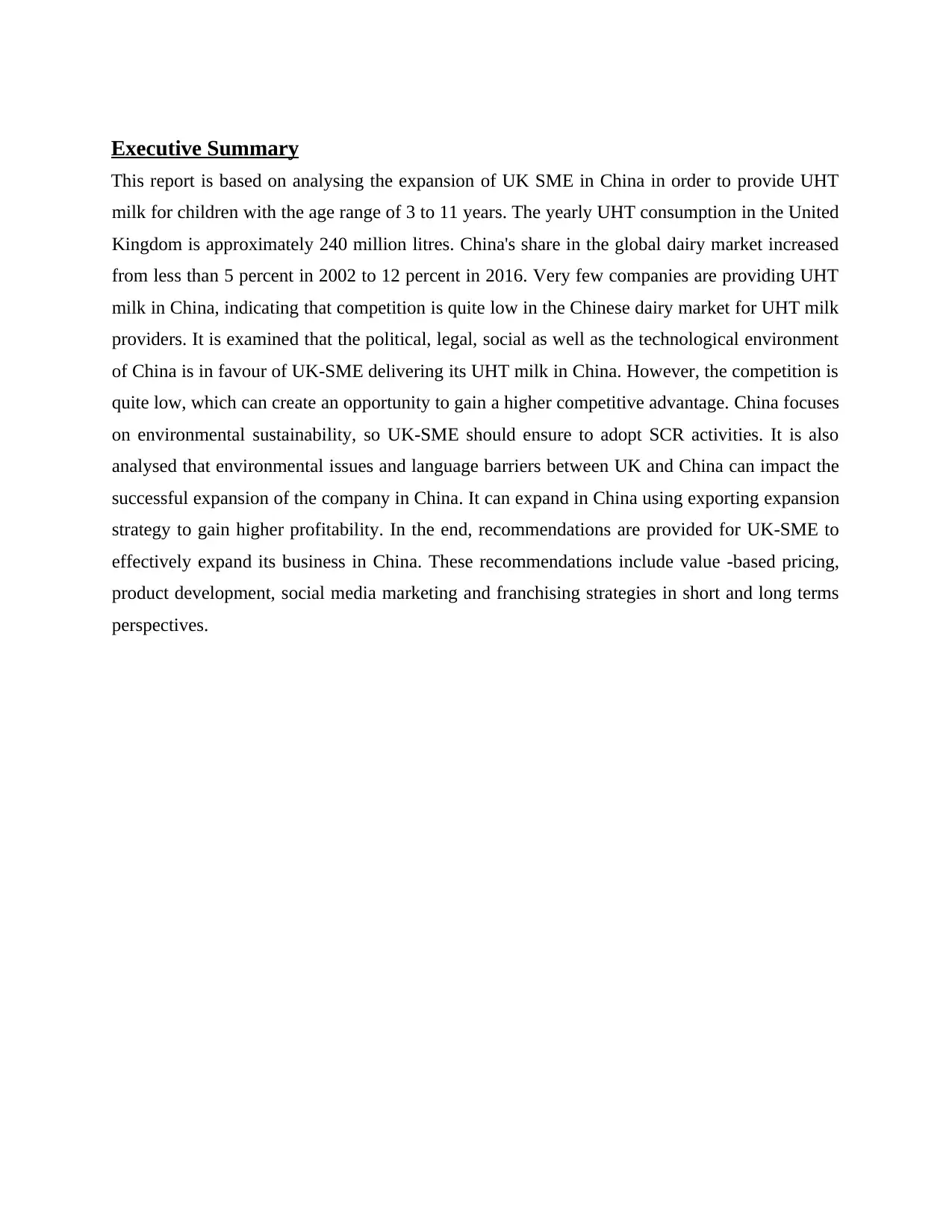
Executive Summary
This report is based on analysing the expansion of UK SME in China in order to provide UHT
milk for children with the age range of 3 to 11 years. The yearly UHT consumption in the United
Kingdom is approximately 240 million litres. China's share in the global dairy market increased
from less than 5 percent in 2002 to 12 percent in 2016. Very few companies are providing UHT
milk in China, indicating that competition is quite low in the Chinese dairy market for UHT milk
providers. It is examined that the political, legal, social as well as the technological environment
of China is in favour of UK-SME delivering its UHT milk in China. However, the competition is
quite low, which can create an opportunity to gain a higher competitive advantage. China focuses
on environmental sustainability, so UK-SME should ensure to adopt SCR activities. It is also
analysed that environmental issues and language barriers between UK and China can impact the
successful expansion of the company in China. It can expand in China using exporting expansion
strategy to gain higher profitability. In the end, recommendations are provided for UK-SME to
effectively expand its business in China. These recommendations include value -based pricing,
product development, social media marketing and franchising strategies in short and long terms
perspectives.
This report is based on analysing the expansion of UK SME in China in order to provide UHT
milk for children with the age range of 3 to 11 years. The yearly UHT consumption in the United
Kingdom is approximately 240 million litres. China's share in the global dairy market increased
from less than 5 percent in 2002 to 12 percent in 2016. Very few companies are providing UHT
milk in China, indicating that competition is quite low in the Chinese dairy market for UHT milk
providers. It is examined that the political, legal, social as well as the technological environment
of China is in favour of UK-SME delivering its UHT milk in China. However, the competition is
quite low, which can create an opportunity to gain a higher competitive advantage. China focuses
on environmental sustainability, so UK-SME should ensure to adopt SCR activities. It is also
analysed that environmental issues and language barriers between UK and China can impact the
successful expansion of the company in China. It can expand in China using exporting expansion
strategy to gain higher profitability. In the end, recommendations are provided for UK-SME to
effectively expand its business in China. These recommendations include value -based pricing,
product development, social media marketing and franchising strategies in short and long terms
perspectives.
Paraphrase This Document
Need a fresh take? Get an instant paraphrase of this document with our AI Paraphraser
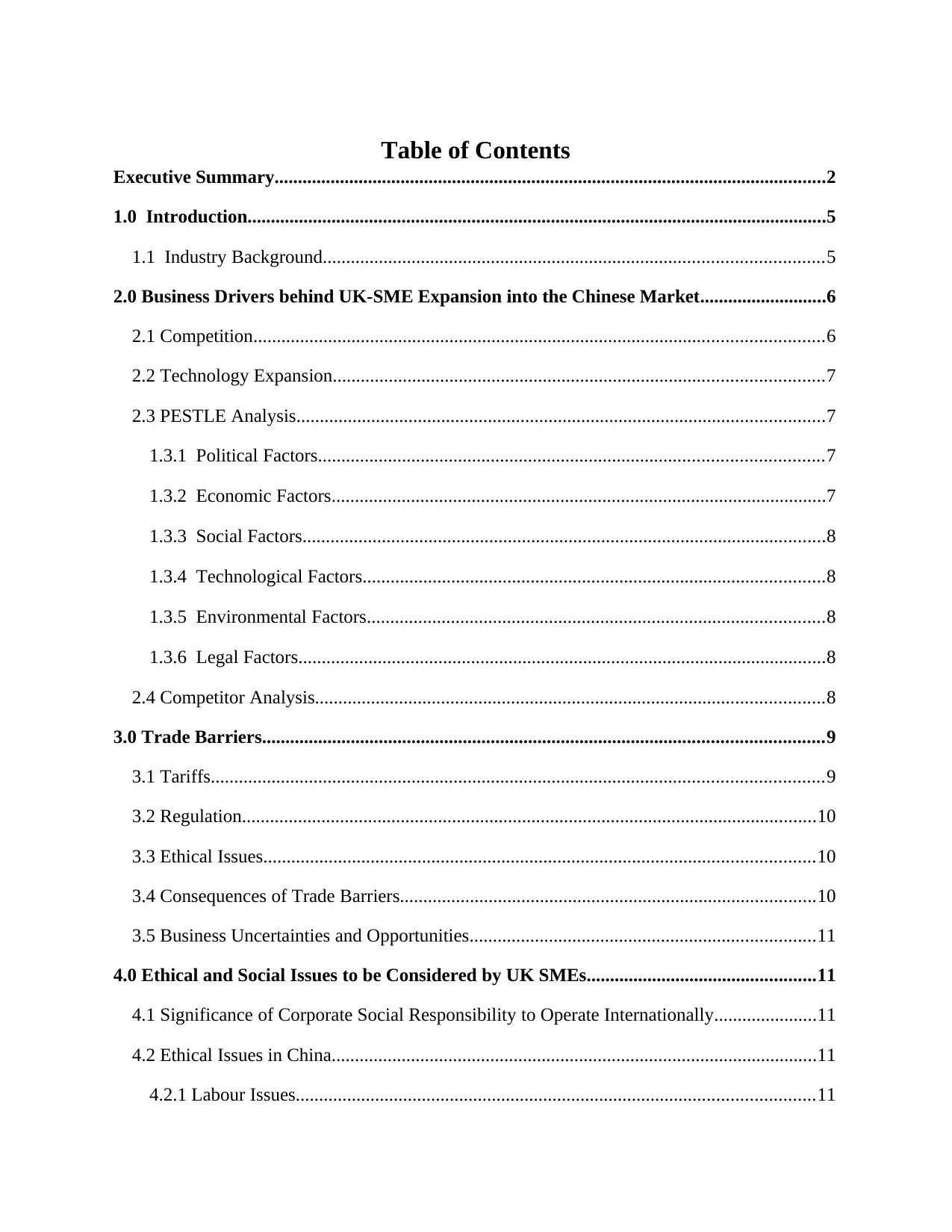
Table of Contents
Executive Summary......................................................................................................................2
1.0 Introduction............................................................................................................................5
1.1 Industry Background...........................................................................................................5
2.0 Business Drivers behind UK-SME Expansion into the Chinese Market...........................6
2.1 Competition..........................................................................................................................6
2.2 Technology Expansion.........................................................................................................7
2.3 PESTLE Analysis.................................................................................................................7
1.3.1 Political Factors............................................................................................................7
1.3.2 Economic Factors..........................................................................................................7
1.3.3 Social Factors................................................................................................................8
1.3.4 Technological Factors...................................................................................................8
1.3.5 Environmental Factors..................................................................................................8
1.3.6 Legal Factors.................................................................................................................8
2.4 Competitor Analysis.............................................................................................................8
3.0 Trade Barriers........................................................................................................................9
3.1 Tariffs...................................................................................................................................9
3.2 Regulation...........................................................................................................................10
3.3 Ethical Issues......................................................................................................................10
3.4 Consequences of Trade Barriers.........................................................................................10
3.5 Business Uncertainties and Opportunities..........................................................................11
4.0 Ethical and Social Issues to be Considered by UK SMEs.................................................11
4.1 Significance of Corporate Social Responsibility to Operate Internationally......................11
4.2 Ethical Issues in China........................................................................................................11
4.2.1 Labour Issues...............................................................................................................11
Executive Summary......................................................................................................................2
1.0 Introduction............................................................................................................................5
1.1 Industry Background...........................................................................................................5
2.0 Business Drivers behind UK-SME Expansion into the Chinese Market...........................6
2.1 Competition..........................................................................................................................6
2.2 Technology Expansion.........................................................................................................7
2.3 PESTLE Analysis.................................................................................................................7
1.3.1 Political Factors............................................................................................................7
1.3.2 Economic Factors..........................................................................................................7
1.3.3 Social Factors................................................................................................................8
1.3.4 Technological Factors...................................................................................................8
1.3.5 Environmental Factors..................................................................................................8
1.3.6 Legal Factors.................................................................................................................8
2.4 Competitor Analysis.............................................................................................................8
3.0 Trade Barriers........................................................................................................................9
3.1 Tariffs...................................................................................................................................9
3.2 Regulation...........................................................................................................................10
3.3 Ethical Issues......................................................................................................................10
3.4 Consequences of Trade Barriers.........................................................................................10
3.5 Business Uncertainties and Opportunities..........................................................................11
4.0 Ethical and Social Issues to be Considered by UK SMEs.................................................11
4.1 Significance of Corporate Social Responsibility to Operate Internationally......................11
4.2 Ethical Issues in China........................................................................................................11
4.2.1 Labour Issues...............................................................................................................11
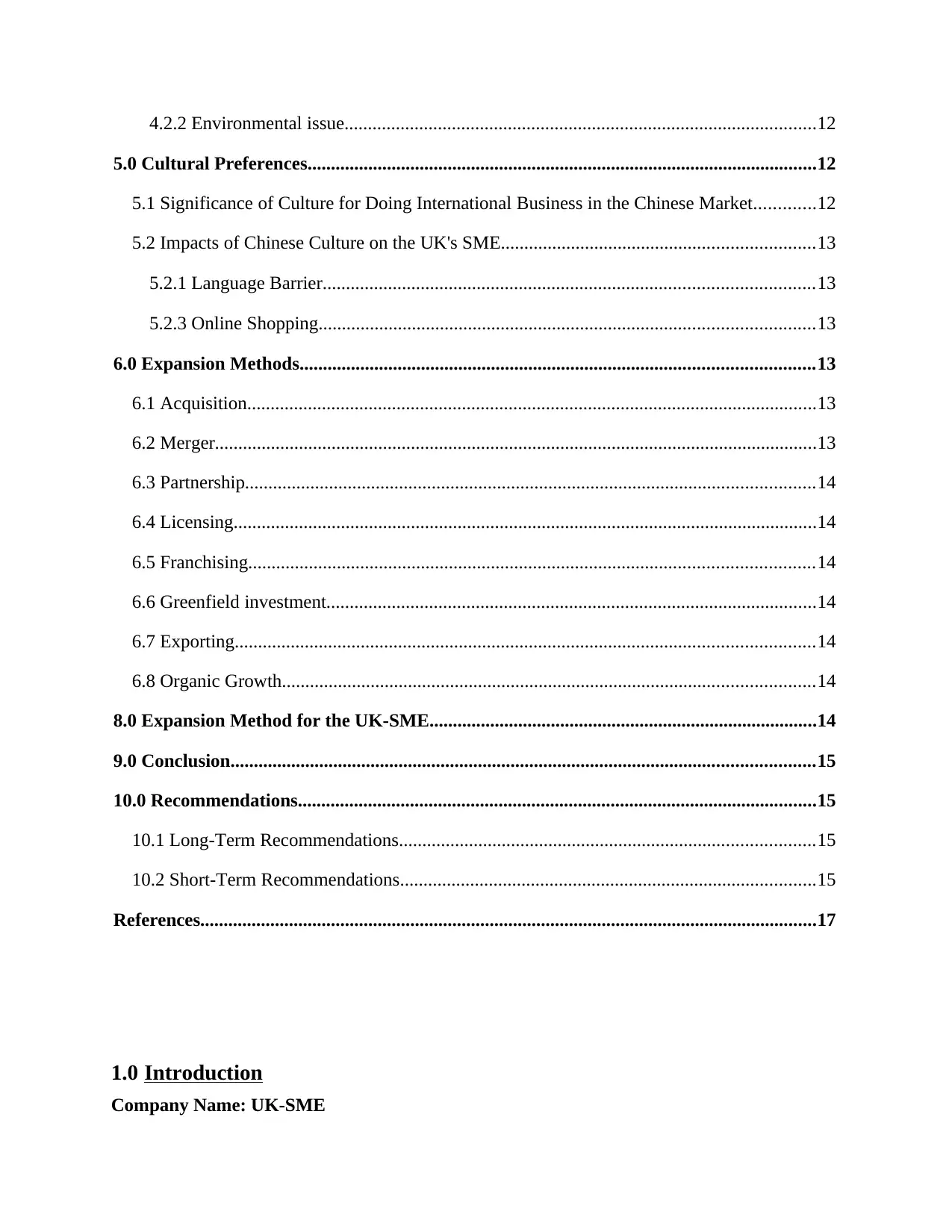
4.2.2 Environmental issue.....................................................................................................12
5.0 Cultural Preferences.............................................................................................................12
5.1 Significance of Culture for Doing International Business in the Chinese Market.............12
5.2 Impacts of Chinese Culture on the UK's SME...................................................................13
5.2.1 Language Barrier.........................................................................................................13
5.2.3 Online Shopping..........................................................................................................13
6.0 Expansion Methods..............................................................................................................13
6.1 Acquisition..........................................................................................................................13
6.2 Merger.................................................................................................................................13
6.3 Partnership..........................................................................................................................14
6.4 Licensing.............................................................................................................................14
6.5 Franchising.........................................................................................................................14
6.6 Greenfield investment.........................................................................................................14
6.7 Exporting............................................................................................................................14
6.8 Organic Growth..................................................................................................................14
8.0 Expansion Method for the UK-SME...................................................................................14
9.0 Conclusion.............................................................................................................................15
10.0 Recommendations...............................................................................................................15
10.1 Long-Term Recommendations.........................................................................................15
10.2 Short-Term Recommendations.........................................................................................15
References....................................................................................................................................17
1.0 Introduction
Company Name: UK-SME
5.0 Cultural Preferences.............................................................................................................12
5.1 Significance of Culture for Doing International Business in the Chinese Market.............12
5.2 Impacts of Chinese Culture on the UK's SME...................................................................13
5.2.1 Language Barrier.........................................................................................................13
5.2.3 Online Shopping..........................................................................................................13
6.0 Expansion Methods..............................................................................................................13
6.1 Acquisition..........................................................................................................................13
6.2 Merger.................................................................................................................................13
6.3 Partnership..........................................................................................................................14
6.4 Licensing.............................................................................................................................14
6.5 Franchising.........................................................................................................................14
6.6 Greenfield investment.........................................................................................................14
6.7 Exporting............................................................................................................................14
6.8 Organic Growth..................................................................................................................14
8.0 Expansion Method for the UK-SME...................................................................................14
9.0 Conclusion.............................................................................................................................15
10.0 Recommendations...............................................................................................................15
10.1 Long-Term Recommendations.........................................................................................15
10.2 Short-Term Recommendations.........................................................................................15
References....................................................................................................................................17
1.0 Introduction
Company Name: UK-SME
⊘ This is a preview!⊘
Do you want full access?
Subscribe today to unlock all pages.

Trusted by 1+ million students worldwide
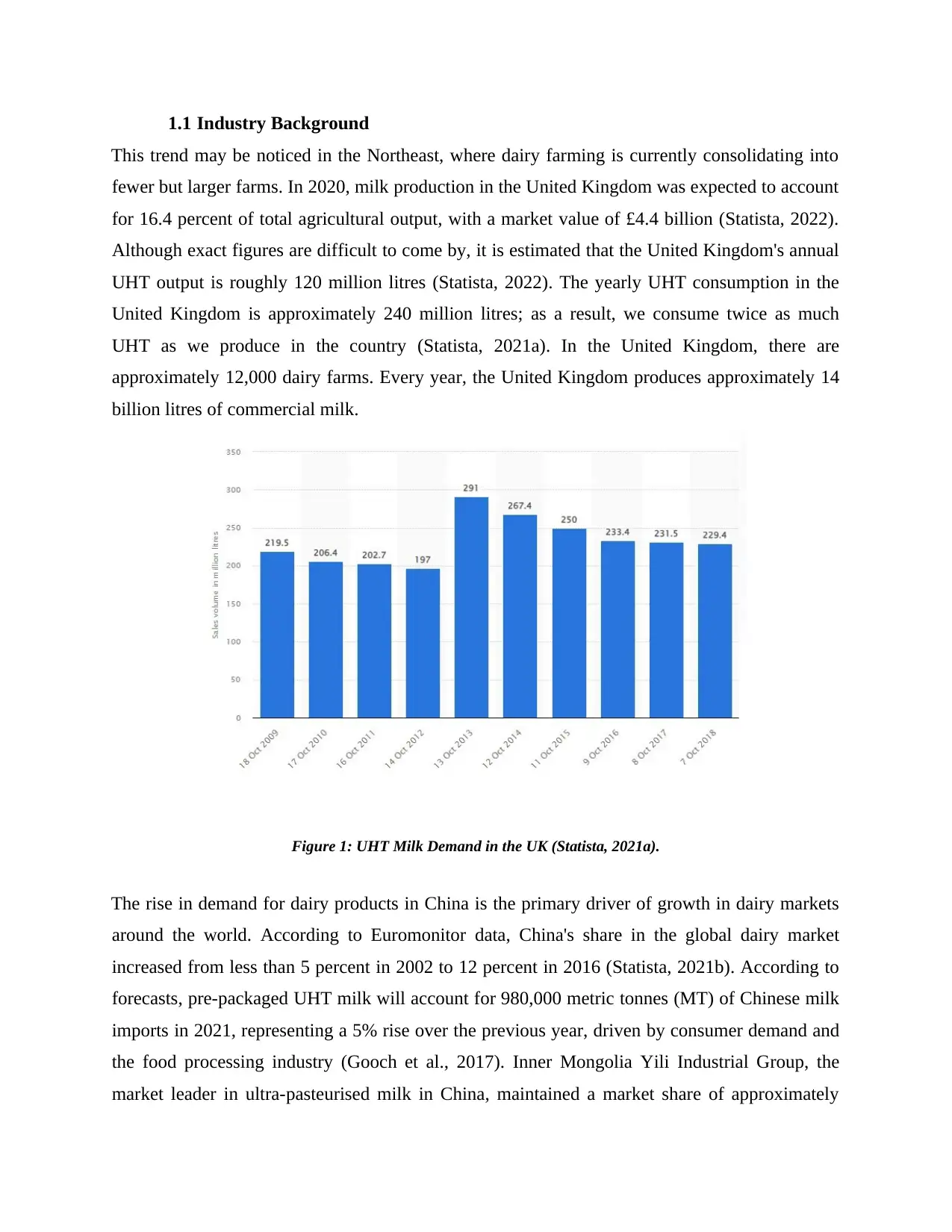
1.1 Industry Background
This trend may be noticed in the Northeast, where dairy farming is currently consolidating into
fewer but larger farms. In 2020, milk production in the United Kingdom was expected to account
for 16.4 percent of total agricultural output, with a market value of £4.4 billion (Statista, 2022).
Although exact figures are difficult to come by, it is estimated that the United Kingdom's annual
UHT output is roughly 120 million litres (Statista, 2022). The yearly UHT consumption in the
United Kingdom is approximately 240 million litres; as a result, we consume twice as much
UHT as we produce in the country (Statista, 2021a). In the United Kingdom, there are
approximately 12,000 dairy farms. Every year, the United Kingdom produces approximately 14
billion litres of commercial milk.
Figure 1: UHT Milk Demand in the UK (Statista, 2021a).
The rise in demand for dairy products in China is the primary driver of growth in dairy markets
around the world. According to Euromonitor data, China's share in the global dairy market
increased from less than 5 percent in 2002 to 12 percent in 2016 (Statista, 2021b). According to
forecasts, pre-packaged UHT milk will account for 980,000 metric tonnes (MT) of Chinese milk
imports in 2021, representing a 5% rise over the previous year, driven by consumer demand and
the food processing industry (Gooch et al., 2017). Inner Mongolia Yili Industrial Group, the
market leader in ultra-pasteurised milk in China, maintained a market share of approximately
This trend may be noticed in the Northeast, where dairy farming is currently consolidating into
fewer but larger farms. In 2020, milk production in the United Kingdom was expected to account
for 16.4 percent of total agricultural output, with a market value of £4.4 billion (Statista, 2022).
Although exact figures are difficult to come by, it is estimated that the United Kingdom's annual
UHT output is roughly 120 million litres (Statista, 2022). The yearly UHT consumption in the
United Kingdom is approximately 240 million litres; as a result, we consume twice as much
UHT as we produce in the country (Statista, 2021a). In the United Kingdom, there are
approximately 12,000 dairy farms. Every year, the United Kingdom produces approximately 14
billion litres of commercial milk.
Figure 1: UHT Milk Demand in the UK (Statista, 2021a).
The rise in demand for dairy products in China is the primary driver of growth in dairy markets
around the world. According to Euromonitor data, China's share in the global dairy market
increased from less than 5 percent in 2002 to 12 percent in 2016 (Statista, 2021b). According to
forecasts, pre-packaged UHT milk will account for 980,000 metric tonnes (MT) of Chinese milk
imports in 2021, representing a 5% rise over the previous year, driven by consumer demand and
the food processing industry (Gooch et al., 2017). Inner Mongolia Yili Industrial Group, the
market leader in ultra-pasteurised milk in China, maintained a market share of approximately
Paraphrase This Document
Need a fresh take? Get an instant paraphrase of this document with our AI Paraphraser
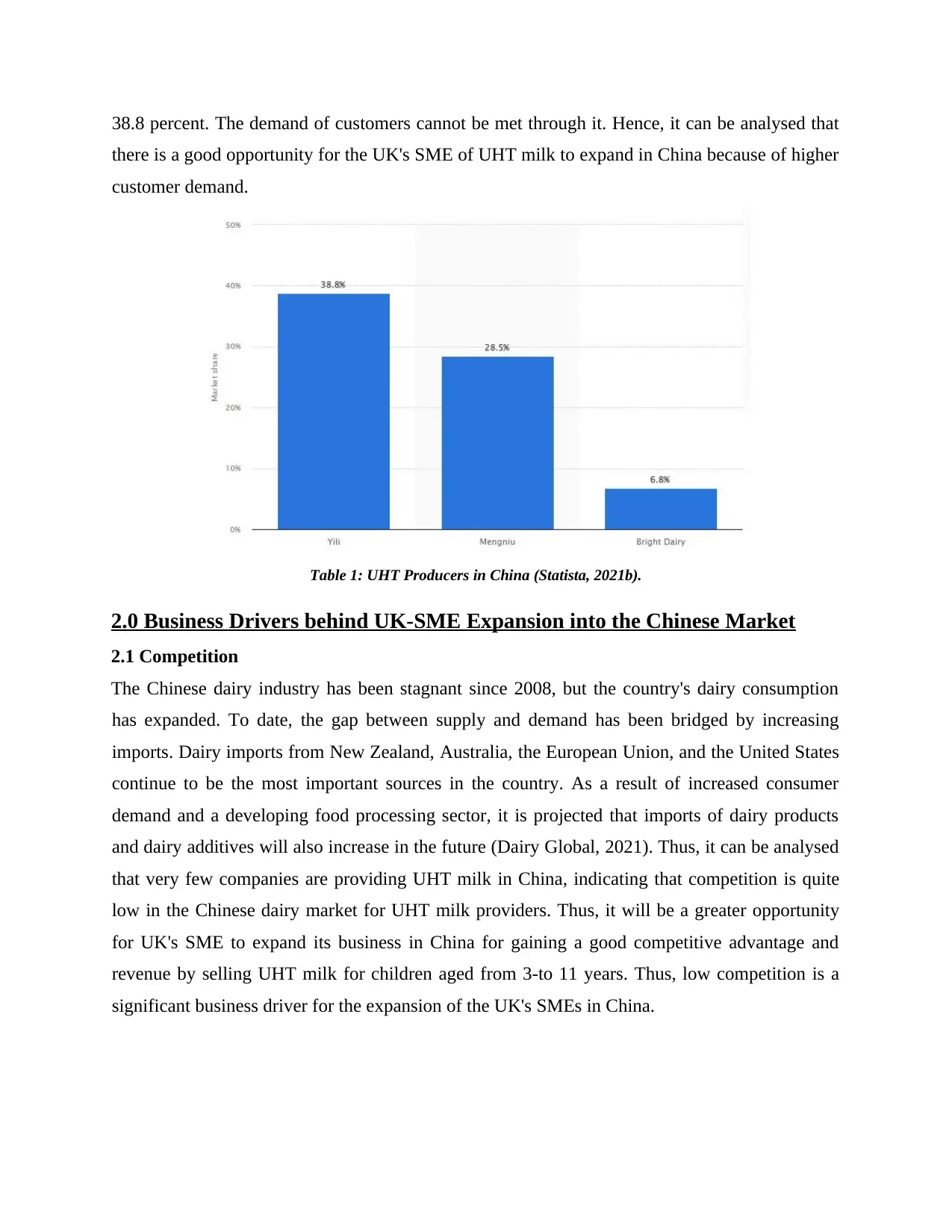
38.8 percent. The demand of customers cannot be met through it. Hence, it can be analysed that
there is a good opportunity for the UK's SME of UHT milk to expand in China because of higher
customer demand.
Table 1: UHT Producers in China (Statista, 2021b).
2.0 Business Drivers behind UK-SME Expansion into the Chinese Market
2.1 Competition
The Chinese dairy industry has been stagnant since 2008, but the country's dairy consumption
has expanded. To date, the gap between supply and demand has been bridged by increasing
imports. Dairy imports from New Zealand, Australia, the European Union, and the United States
continue to be the most important sources in the country. As a result of increased consumer
demand and a developing food processing sector, it is projected that imports of dairy products
and dairy additives will also increase in the future (Dairy Global, 2021). Thus, it can be analysed
that very few companies are providing UHT milk in China, indicating that competition is quite
low in the Chinese dairy market for UHT milk providers. Thus, it will be a greater opportunity
for UK's SME to expand its business in China for gaining a good competitive advantage and
revenue by selling UHT milk for children aged from 3-to 11 years. Thus, low competition is a
significant business driver for the expansion of the UK's SMEs in China.
there is a good opportunity for the UK's SME of UHT milk to expand in China because of higher
customer demand.
Table 1: UHT Producers in China (Statista, 2021b).
2.0 Business Drivers behind UK-SME Expansion into the Chinese Market
2.1 Competition
The Chinese dairy industry has been stagnant since 2008, but the country's dairy consumption
has expanded. To date, the gap between supply and demand has been bridged by increasing
imports. Dairy imports from New Zealand, Australia, the European Union, and the United States
continue to be the most important sources in the country. As a result of increased consumer
demand and a developing food processing sector, it is projected that imports of dairy products
and dairy additives will also increase in the future (Dairy Global, 2021). Thus, it can be analysed
that very few companies are providing UHT milk in China, indicating that competition is quite
low in the Chinese dairy market for UHT milk providers. Thus, it will be a greater opportunity
for UK's SME to expand its business in China for gaining a good competitive advantage and
revenue by selling UHT milk for children aged from 3-to 11 years. Thus, low competition is a
significant business driver for the expansion of the UK's SMEs in China.
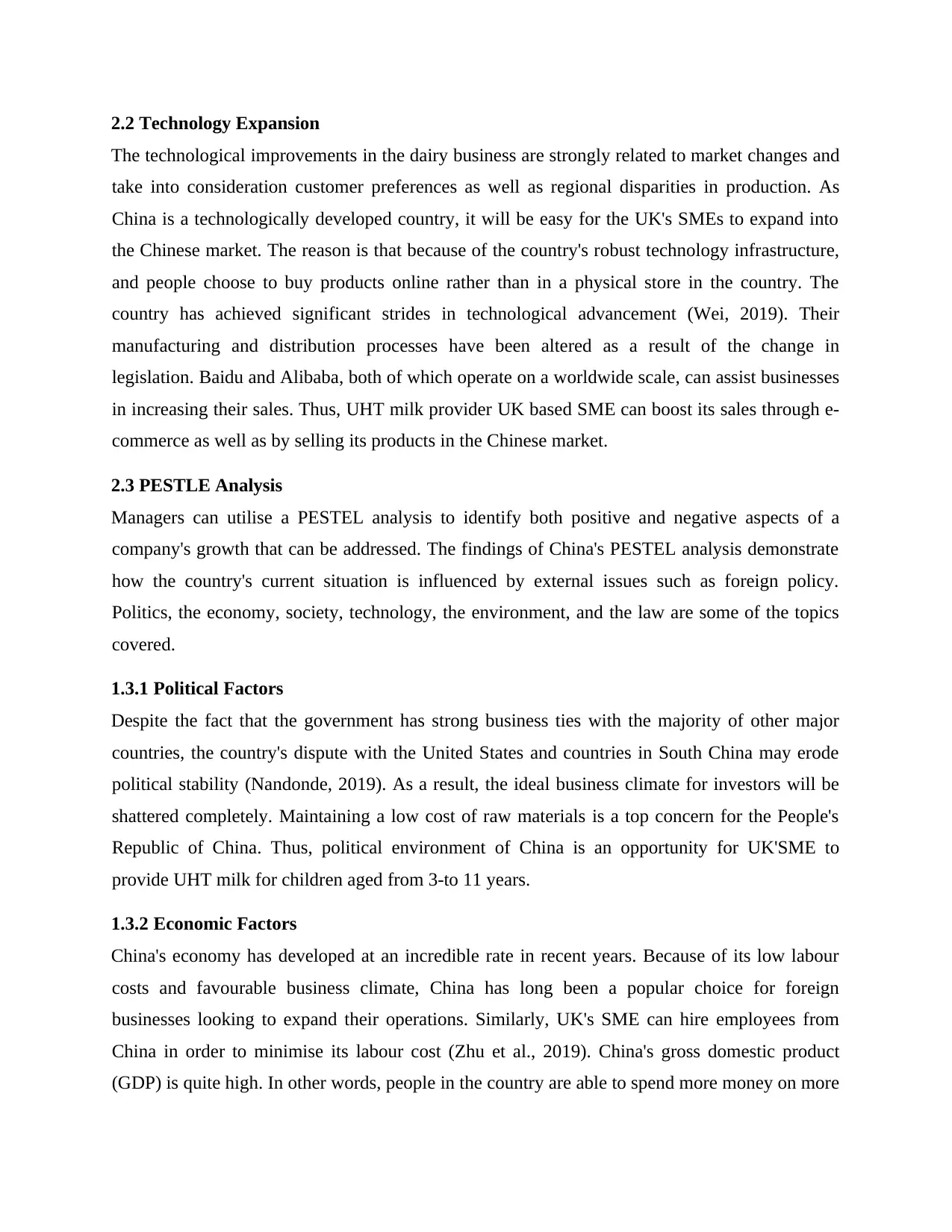
2.2 Technology Expansion
The technological improvements in the dairy business are strongly related to market changes and
take into consideration customer preferences as well as regional disparities in production. As
China is a technologically developed country, it will be easy for the UK's SMEs to expand into
the Chinese market. The reason is that because of the country's robust technology infrastructure,
and people choose to buy products online rather than in a physical store in the country. The
country has achieved significant strides in technological advancement (Wei, 2019). Their
manufacturing and distribution processes have been altered as a result of the change in
legislation. Baidu and Alibaba, both of which operate on a worldwide scale, can assist businesses
in increasing their sales. Thus, UHT milk provider UK based SME can boost its sales through e-
commerce as well as by selling its products in the Chinese market.
2.3 PESTLE Analysis
Managers can utilise a PESTEL analysis to identify both positive and negative aspects of a
company's growth that can be addressed. The findings of China's PESTEL analysis demonstrate
how the country's current situation is influenced by external issues such as foreign policy.
Politics, the economy, society, technology, the environment, and the law are some of the topics
covered.
1.3.1 Political Factors
Despite the fact that the government has strong business ties with the majority of other major
countries, the country's dispute with the United States and countries in South China may erode
political stability (Nandonde, 2019). As a result, the ideal business climate for investors will be
shattered completely. Maintaining a low cost of raw materials is a top concern for the People's
Republic of China. Thus, political environment of China is an opportunity for UK'SME to
provide UHT milk for children aged from 3-to 11 years.
1.3.2 Economic Factors
China's economy has developed at an incredible rate in recent years. Because of its low labour
costs and favourable business climate, China has long been a popular choice for foreign
businesses looking to expand their operations. Similarly, UK's SME can hire employees from
China in order to minimise its labour cost (Zhu et al., 2019). China's gross domestic product
(GDP) is quite high. In other words, people in the country are able to spend more money on more
The technological improvements in the dairy business are strongly related to market changes and
take into consideration customer preferences as well as regional disparities in production. As
China is a technologically developed country, it will be easy for the UK's SMEs to expand into
the Chinese market. The reason is that because of the country's robust technology infrastructure,
and people choose to buy products online rather than in a physical store in the country. The
country has achieved significant strides in technological advancement (Wei, 2019). Their
manufacturing and distribution processes have been altered as a result of the change in
legislation. Baidu and Alibaba, both of which operate on a worldwide scale, can assist businesses
in increasing their sales. Thus, UHT milk provider UK based SME can boost its sales through e-
commerce as well as by selling its products in the Chinese market.
2.3 PESTLE Analysis
Managers can utilise a PESTEL analysis to identify both positive and negative aspects of a
company's growth that can be addressed. The findings of China's PESTEL analysis demonstrate
how the country's current situation is influenced by external issues such as foreign policy.
Politics, the economy, society, technology, the environment, and the law are some of the topics
covered.
1.3.1 Political Factors
Despite the fact that the government has strong business ties with the majority of other major
countries, the country's dispute with the United States and countries in South China may erode
political stability (Nandonde, 2019). As a result, the ideal business climate for investors will be
shattered completely. Maintaining a low cost of raw materials is a top concern for the People's
Republic of China. Thus, political environment of China is an opportunity for UK'SME to
provide UHT milk for children aged from 3-to 11 years.
1.3.2 Economic Factors
China's economy has developed at an incredible rate in recent years. Because of its low labour
costs and favourable business climate, China has long been a popular choice for foreign
businesses looking to expand their operations. Similarly, UK's SME can hire employees from
China in order to minimise its labour cost (Zhu et al., 2019). China's gross domestic product
(GDP) is quite high. In other words, people in the country are able to spend more money on more
⊘ This is a preview!⊘
Do you want full access?
Subscribe today to unlock all pages.

Trusted by 1+ million students worldwide
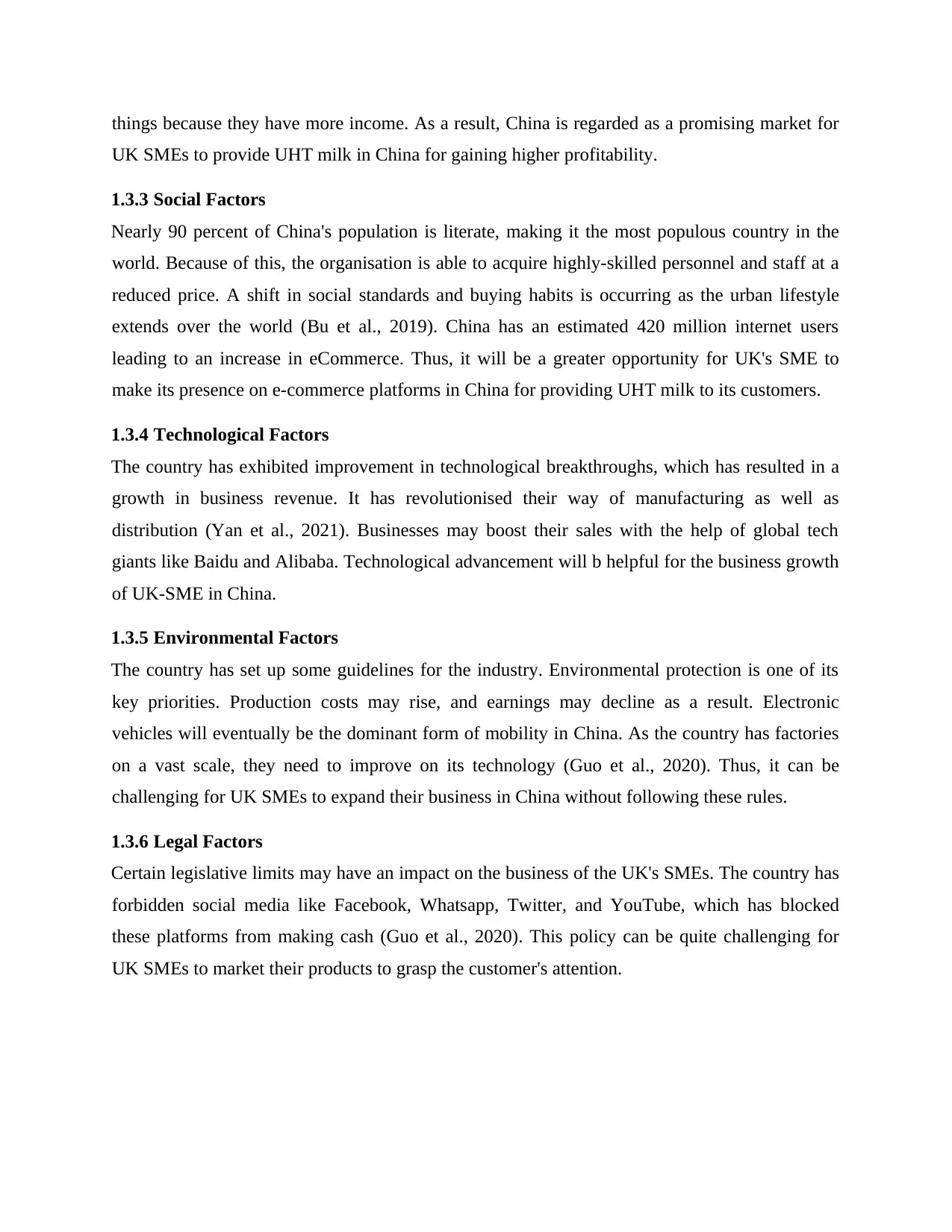
things because they have more income. As a result, China is regarded as a promising market for
UK SMEs to provide UHT milk in China for gaining higher profitability.
1.3.3 Social Factors
Nearly 90 percent of China's population is literate, making it the most populous country in the
world. Because of this, the organisation is able to acquire highly-skilled personnel and staff at a
reduced price. A shift in social standards and buying habits is occurring as the urban lifestyle
extends over the world (Bu et al., 2019). China has an estimated 420 million internet users
leading to an increase in eCommerce. Thus, it will be a greater opportunity for UK's SME to
make its presence on e-commerce platforms in China for providing UHT milk to its customers.
1.3.4 Technological Factors
The country has exhibited improvement in technological breakthroughs, which has resulted in a
growth in business revenue. It has revolutionised their way of manufacturing as well as
distribution (Yan et al., 2021). Businesses may boost their sales with the help of global tech
giants like Baidu and Alibaba. Technological advancement will b helpful for the business growth
of UK-SME in China.
1.3.5 Environmental Factors
The country has set up some guidelines for the industry. Environmental protection is one of its
key priorities. Production costs may rise, and earnings may decline as a result. Electronic
vehicles will eventually be the dominant form of mobility in China. As the country has factories
on a vast scale, they need to improve on its technology (Guo et al., 2020). Thus, it can be
challenging for UK SMEs to expand their business in China without following these rules.
1.3.6 Legal Factors
Certain legislative limits may have an impact on the business of the UK's SMEs. The country has
forbidden social media like Facebook, Whatsapp, Twitter, and YouTube, which has blocked
these platforms from making cash (Guo et al., 2020). This policy can be quite challenging for
UK SMEs to market their products to grasp the customer's attention.
UK SMEs to provide UHT milk in China for gaining higher profitability.
1.3.3 Social Factors
Nearly 90 percent of China's population is literate, making it the most populous country in the
world. Because of this, the organisation is able to acquire highly-skilled personnel and staff at a
reduced price. A shift in social standards and buying habits is occurring as the urban lifestyle
extends over the world (Bu et al., 2019). China has an estimated 420 million internet users
leading to an increase in eCommerce. Thus, it will be a greater opportunity for UK's SME to
make its presence on e-commerce platforms in China for providing UHT milk to its customers.
1.3.4 Technological Factors
The country has exhibited improvement in technological breakthroughs, which has resulted in a
growth in business revenue. It has revolutionised their way of manufacturing as well as
distribution (Yan et al., 2021). Businesses may boost their sales with the help of global tech
giants like Baidu and Alibaba. Technological advancement will b helpful for the business growth
of UK-SME in China.
1.3.5 Environmental Factors
The country has set up some guidelines for the industry. Environmental protection is one of its
key priorities. Production costs may rise, and earnings may decline as a result. Electronic
vehicles will eventually be the dominant form of mobility in China. As the country has factories
on a vast scale, they need to improve on its technology (Guo et al., 2020). Thus, it can be
challenging for UK SMEs to expand their business in China without following these rules.
1.3.6 Legal Factors
Certain legislative limits may have an impact on the business of the UK's SMEs. The country has
forbidden social media like Facebook, Whatsapp, Twitter, and YouTube, which has blocked
these platforms from making cash (Guo et al., 2020). This policy can be quite challenging for
UK SMEs to market their products to grasp the customer's attention.
Paraphrase This Document
Need a fresh take? Get an instant paraphrase of this document with our AI Paraphraser
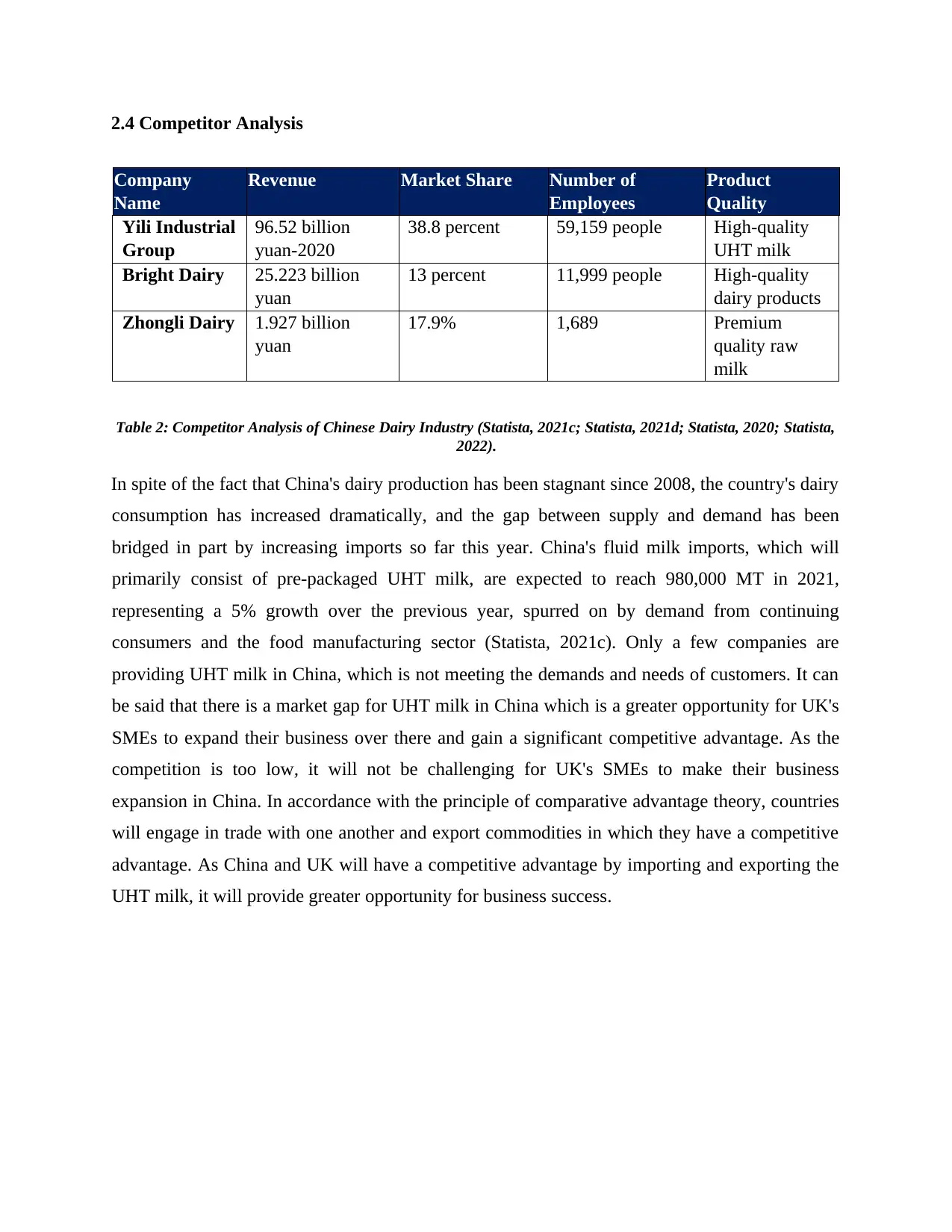
2.4 Competitor Analysis
Company
Name
Revenue Market Share Number of
Employees
Product
Quality
Yili Industrial
Group
96.52 billion
yuan-2020
38.8 percent 59,159 people High-quality
UHT milk
Bright Dairy 25.223 billion
yuan
13 percent 11,999 people High-quality
dairy products
Zhongli Dairy 1.927 billion
yuan
17.9% 1,689 Premium
quality raw
milk
Table 2: Competitor Analysis of Chinese Dairy Industry (Statista, 2021c; Statista, 2021d; Statista, 2020; Statista,
2022).
In spite of the fact that China's dairy production has been stagnant since 2008, the country's dairy
consumption has increased dramatically, and the gap between supply and demand has been
bridged in part by increasing imports so far this year. China's fluid milk imports, which will
primarily consist of pre-packaged UHT milk, are expected to reach 980,000 MT in 2021,
representing a 5% growth over the previous year, spurred on by demand from continuing
consumers and the food manufacturing sector (Statista, 2021c). Only a few companies are
providing UHT milk in China, which is not meeting the demands and needs of customers. It can
be said that there is a market gap for UHT milk in China which is a greater opportunity for UK's
SMEs to expand their business over there and gain a significant competitive advantage. As the
competition is too low, it will not be challenging for UK's SMEs to make their business
expansion in China. In accordance with the principle of comparative advantage theory, countries
will engage in trade with one another and export commodities in which they have a competitive
advantage. As China and UK will have a competitive advantage by importing and exporting the
UHT milk, it will provide greater opportunity for business success.
Company
Name
Revenue Market Share Number of
Employees
Product
Quality
Yili Industrial
Group
96.52 billion
yuan-2020
38.8 percent 59,159 people High-quality
UHT milk
Bright Dairy 25.223 billion
yuan
13 percent 11,999 people High-quality
dairy products
Zhongli Dairy 1.927 billion
yuan
17.9% 1,689 Premium
quality raw
milk
Table 2: Competitor Analysis of Chinese Dairy Industry (Statista, 2021c; Statista, 2021d; Statista, 2020; Statista,
2022).
In spite of the fact that China's dairy production has been stagnant since 2008, the country's dairy
consumption has increased dramatically, and the gap between supply and demand has been
bridged in part by increasing imports so far this year. China's fluid milk imports, which will
primarily consist of pre-packaged UHT milk, are expected to reach 980,000 MT in 2021,
representing a 5% growth over the previous year, spurred on by demand from continuing
consumers and the food manufacturing sector (Statista, 2021c). Only a few companies are
providing UHT milk in China, which is not meeting the demands and needs of customers. It can
be said that there is a market gap for UHT milk in China which is a greater opportunity for UK's
SMEs to expand their business over there and gain a significant competitive advantage. As the
competition is too low, it will not be challenging for UK's SMEs to make their business
expansion in China. In accordance with the principle of comparative advantage theory, countries
will engage in trade with one another and export commodities in which they have a competitive
advantage. As China and UK will have a competitive advantage by importing and exporting the
UHT milk, it will provide greater opportunity for business success.
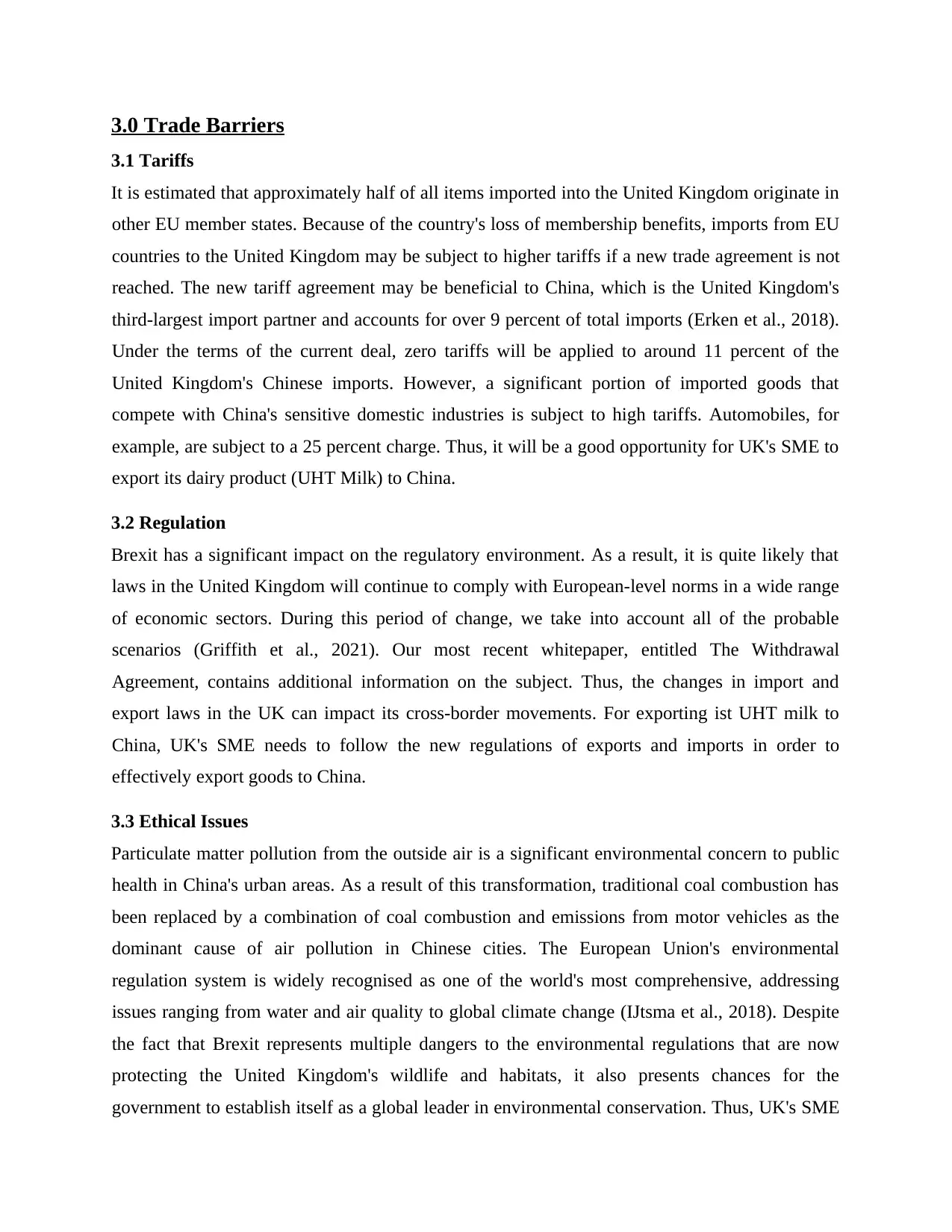
3.0 Trade Barriers
3.1 Tariffs
It is estimated that approximately half of all items imported into the United Kingdom originate in
other EU member states. Because of the country's loss of membership benefits, imports from EU
countries to the United Kingdom may be subject to higher tariffs if a new trade agreement is not
reached. The new tariff agreement may be beneficial to China, which is the United Kingdom's
third-largest import partner and accounts for over 9 percent of total imports (Erken et al., 2018).
Under the terms of the current deal, zero tariffs will be applied to around 11 percent of the
United Kingdom's Chinese imports. However, a significant portion of imported goods that
compete with China's sensitive domestic industries is subject to high tariffs. Automobiles, for
example, are subject to a 25 percent charge. Thus, it will be a good opportunity for UK's SME to
export its dairy product (UHT Milk) to China.
3.2 Regulation
Brexit has a significant impact on the regulatory environment. As a result, it is quite likely that
laws in the United Kingdom will continue to comply with European-level norms in a wide range
of economic sectors. During this period of change, we take into account all of the probable
scenarios (Griffith et al., 2021). Our most recent whitepaper, entitled The Withdrawal
Agreement, contains additional information on the subject. Thus, the changes in import and
export laws in the UK can impact its cross-border movements. For exporting ist UHT milk to
China, UK's SME needs to follow the new regulations of exports and imports in order to
effectively export goods to China.
3.3 Ethical Issues
Particulate matter pollution from the outside air is a significant environmental concern to public
health in China's urban areas. As a result of this transformation, traditional coal combustion has
been replaced by a combination of coal combustion and emissions from motor vehicles as the
dominant cause of air pollution in Chinese cities. The European Union's environmental
regulation system is widely recognised as one of the world's most comprehensive, addressing
issues ranging from water and air quality to global climate change (IJtsma et al., 2018). Despite
the fact that Brexit represents multiple dangers to the environmental regulations that are now
protecting the United Kingdom's wildlife and habitats, it also presents chances for the
government to establish itself as a global leader in environmental conservation. Thus, UK's SME
3.1 Tariffs
It is estimated that approximately half of all items imported into the United Kingdom originate in
other EU member states. Because of the country's loss of membership benefits, imports from EU
countries to the United Kingdom may be subject to higher tariffs if a new trade agreement is not
reached. The new tariff agreement may be beneficial to China, which is the United Kingdom's
third-largest import partner and accounts for over 9 percent of total imports (Erken et al., 2018).
Under the terms of the current deal, zero tariffs will be applied to around 11 percent of the
United Kingdom's Chinese imports. However, a significant portion of imported goods that
compete with China's sensitive domestic industries is subject to high tariffs. Automobiles, for
example, are subject to a 25 percent charge. Thus, it will be a good opportunity for UK's SME to
export its dairy product (UHT Milk) to China.
3.2 Regulation
Brexit has a significant impact on the regulatory environment. As a result, it is quite likely that
laws in the United Kingdom will continue to comply with European-level norms in a wide range
of economic sectors. During this period of change, we take into account all of the probable
scenarios (Griffith et al., 2021). Our most recent whitepaper, entitled The Withdrawal
Agreement, contains additional information on the subject. Thus, the changes in import and
export laws in the UK can impact its cross-border movements. For exporting ist UHT milk to
China, UK's SME needs to follow the new regulations of exports and imports in order to
effectively export goods to China.
3.3 Ethical Issues
Particulate matter pollution from the outside air is a significant environmental concern to public
health in China's urban areas. As a result of this transformation, traditional coal combustion has
been replaced by a combination of coal combustion and emissions from motor vehicles as the
dominant cause of air pollution in Chinese cities. The European Union's environmental
regulation system is widely recognised as one of the world's most comprehensive, addressing
issues ranging from water and air quality to global climate change (IJtsma et al., 2018). Despite
the fact that Brexit represents multiple dangers to the environmental regulations that are now
protecting the United Kingdom's wildlife and habitats, it also presents chances for the
government to establish itself as a global leader in environmental conservation. Thus, UK's SME
⊘ This is a preview!⊘
Do you want full access?
Subscribe today to unlock all pages.

Trusted by 1+ million students worldwide
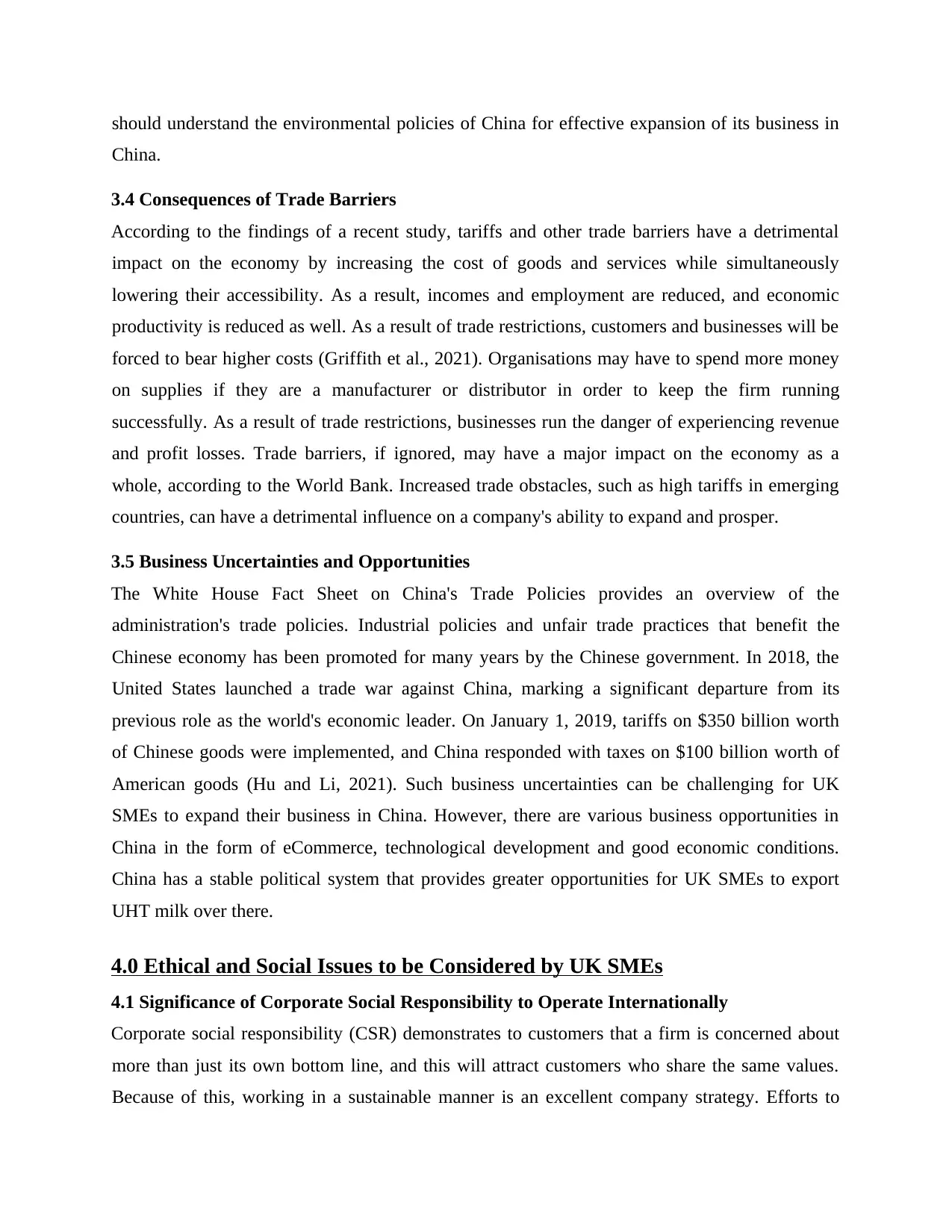
should understand the environmental policies of China for effective expansion of its business in
China.
3.4 Consequences of Trade Barriers
According to the findings of a recent study, tariffs and other trade barriers have a detrimental
impact on the economy by increasing the cost of goods and services while simultaneously
lowering their accessibility. As a result, incomes and employment are reduced, and economic
productivity is reduced as well. As a result of trade restrictions, customers and businesses will be
forced to bear higher costs (Griffith et al., 2021). Organisations may have to spend more money
on supplies if they are a manufacturer or distributor in order to keep the firm running
successfully. As a result of trade restrictions, businesses run the danger of experiencing revenue
and profit losses. Trade barriers, if ignored, may have a major impact on the economy as a
whole, according to the World Bank. Increased trade obstacles, such as high tariffs in emerging
countries, can have a detrimental influence on a company's ability to expand and prosper.
3.5 Business Uncertainties and Opportunities
The White House Fact Sheet on China's Trade Policies provides an overview of the
administration's trade policies. Industrial policies and unfair trade practices that benefit the
Chinese economy has been promoted for many years by the Chinese government. In 2018, the
United States launched a trade war against China, marking a significant departure from its
previous role as the world's economic leader. On January 1, 2019, tariffs on $350 billion worth
of Chinese goods were implemented, and China responded with taxes on $100 billion worth of
American goods (Hu and Li, 2021). Such business uncertainties can be challenging for UK
SMEs to expand their business in China. However, there are various business opportunities in
China in the form of eCommerce, technological development and good economic conditions.
China has a stable political system that provides greater opportunities for UK SMEs to export
UHT milk over there.
4.0 Ethical and Social Issues to be Considered by UK SMEs
4.1 Significance of Corporate Social Responsibility to Operate Internationally
Corporate social responsibility (CSR) demonstrates to customers that a firm is concerned about
more than just its own bottom line, and this will attract customers who share the same values.
Because of this, working in a sustainable manner is an excellent company strategy. Efforts to
China.
3.4 Consequences of Trade Barriers
According to the findings of a recent study, tariffs and other trade barriers have a detrimental
impact on the economy by increasing the cost of goods and services while simultaneously
lowering their accessibility. As a result, incomes and employment are reduced, and economic
productivity is reduced as well. As a result of trade restrictions, customers and businesses will be
forced to bear higher costs (Griffith et al., 2021). Organisations may have to spend more money
on supplies if they are a manufacturer or distributor in order to keep the firm running
successfully. As a result of trade restrictions, businesses run the danger of experiencing revenue
and profit losses. Trade barriers, if ignored, may have a major impact on the economy as a
whole, according to the World Bank. Increased trade obstacles, such as high tariffs in emerging
countries, can have a detrimental influence on a company's ability to expand and prosper.
3.5 Business Uncertainties and Opportunities
The White House Fact Sheet on China's Trade Policies provides an overview of the
administration's trade policies. Industrial policies and unfair trade practices that benefit the
Chinese economy has been promoted for many years by the Chinese government. In 2018, the
United States launched a trade war against China, marking a significant departure from its
previous role as the world's economic leader. On January 1, 2019, tariffs on $350 billion worth
of Chinese goods were implemented, and China responded with taxes on $100 billion worth of
American goods (Hu and Li, 2021). Such business uncertainties can be challenging for UK
SMEs to expand their business in China. However, there are various business opportunities in
China in the form of eCommerce, technological development and good economic conditions.
China has a stable political system that provides greater opportunities for UK SMEs to export
UHT milk over there.
4.0 Ethical and Social Issues to be Considered by UK SMEs
4.1 Significance of Corporate Social Responsibility to Operate Internationally
Corporate social responsibility (CSR) demonstrates to customers that a firm is concerned about
more than just its own bottom line, and this will attract customers who share the same values.
Because of this, working in a sustainable manner is an excellent company strategy. Efforts to
Paraphrase This Document
Need a fresh take? Get an instant paraphrase of this document with our AI Paraphraser
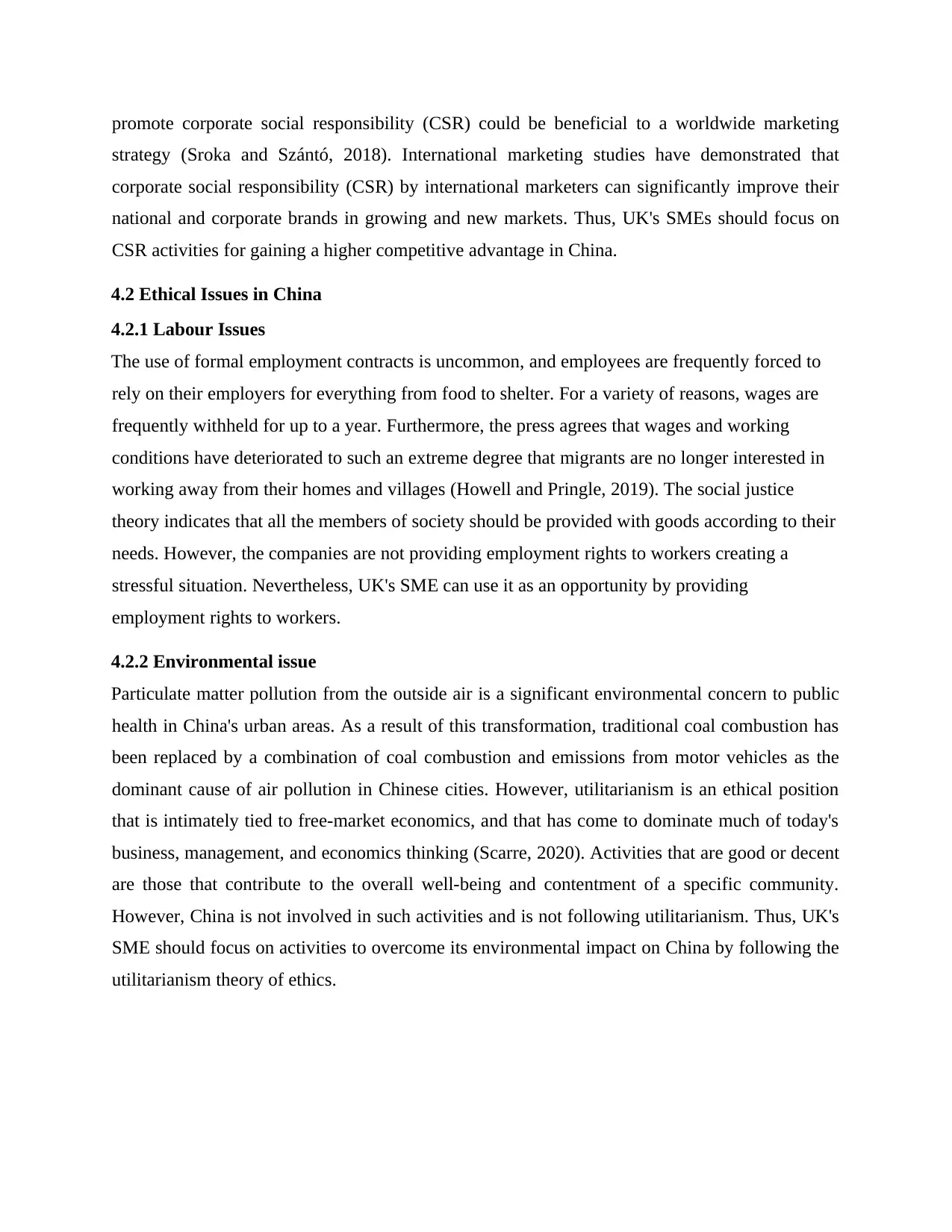
promote corporate social responsibility (CSR) could be beneficial to a worldwide marketing
strategy (Sroka and Szántó, 2018). International marketing studies have demonstrated that
corporate social responsibility (CSR) by international marketers can significantly improve their
national and corporate brands in growing and new markets. Thus, UK's SMEs should focus on
CSR activities for gaining a higher competitive advantage in China.
4.2 Ethical Issues in China
4.2.1 Labour Issues
The use of formal employment contracts is uncommon, and employees are frequently forced to
rely on their employers for everything from food to shelter. For a variety of reasons, wages are
frequently withheld for up to a year. Furthermore, the press agrees that wages and working
conditions have deteriorated to such an extreme degree that migrants are no longer interested in
working away from their homes and villages (Howell and Pringle, 2019). The social justice
theory indicates that all the members of society should be provided with goods according to their
needs. However, the companies are not providing employment rights to workers creating a
stressful situation. Nevertheless, UK's SME can use it as an opportunity by providing
employment rights to workers.
4.2.2 Environmental issue
Particulate matter pollution from the outside air is a significant environmental concern to public
health in China's urban areas. As a result of this transformation, traditional coal combustion has
been replaced by a combination of coal combustion and emissions from motor vehicles as the
dominant cause of air pollution in Chinese cities. However, utilitarianism is an ethical position
that is intimately tied to free-market economics, and that has come to dominate much of today's
business, management, and economics thinking (Scarre, 2020). Activities that are good or decent
are those that contribute to the overall well-being and contentment of a specific community.
However, China is not involved in such activities and is not following utilitarianism. Thus, UK's
SME should focus on activities to overcome its environmental impact on China by following the
utilitarianism theory of ethics.
strategy (Sroka and Szántó, 2018). International marketing studies have demonstrated that
corporate social responsibility (CSR) by international marketers can significantly improve their
national and corporate brands in growing and new markets. Thus, UK's SMEs should focus on
CSR activities for gaining a higher competitive advantage in China.
4.2 Ethical Issues in China
4.2.1 Labour Issues
The use of formal employment contracts is uncommon, and employees are frequently forced to
rely on their employers for everything from food to shelter. For a variety of reasons, wages are
frequently withheld for up to a year. Furthermore, the press agrees that wages and working
conditions have deteriorated to such an extreme degree that migrants are no longer interested in
working away from their homes and villages (Howell and Pringle, 2019). The social justice
theory indicates that all the members of society should be provided with goods according to their
needs. However, the companies are not providing employment rights to workers creating a
stressful situation. Nevertheless, UK's SME can use it as an opportunity by providing
employment rights to workers.
4.2.2 Environmental issue
Particulate matter pollution from the outside air is a significant environmental concern to public
health in China's urban areas. As a result of this transformation, traditional coal combustion has
been replaced by a combination of coal combustion and emissions from motor vehicles as the
dominant cause of air pollution in Chinese cities. However, utilitarianism is an ethical position
that is intimately tied to free-market economics, and that has come to dominate much of today's
business, management, and economics thinking (Scarre, 2020). Activities that are good or decent
are those that contribute to the overall well-being and contentment of a specific community.
However, China is not involved in such activities and is not following utilitarianism. Thus, UK's
SME should focus on activities to overcome its environmental impact on China by following the
utilitarianism theory of ethics.
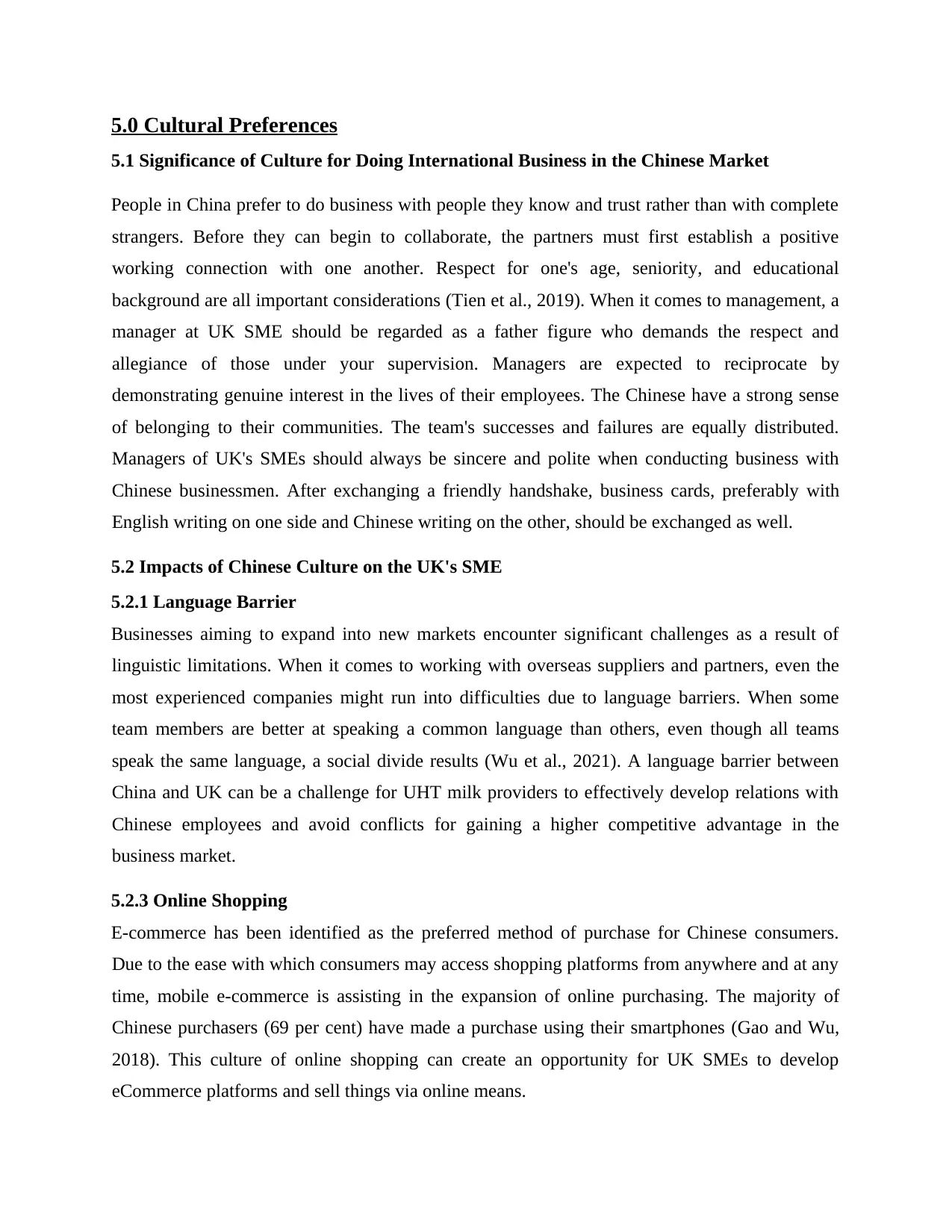
5.0 Cultural Preferences
5.1 Significance of Culture for Doing International Business in the Chinese Market
People in China prefer to do business with people they know and trust rather than with complete
strangers. Before they can begin to collaborate, the partners must first establish a positive
working connection with one another. Respect for one's age, seniority, and educational
background are all important considerations (Tien et al., 2019). When it comes to management, a
manager at UK SME should be regarded as a father figure who demands the respect and
allegiance of those under your supervision. Managers are expected to reciprocate by
demonstrating genuine interest in the lives of their employees. The Chinese have a strong sense
of belonging to their communities. The team's successes and failures are equally distributed.
Managers of UK's SMEs should always be sincere and polite when conducting business with
Chinese businessmen. After exchanging a friendly handshake, business cards, preferably with
English writing on one side and Chinese writing on the other, should be exchanged as well.
5.2 Impacts of Chinese Culture on the UK's SME
5.2.1 Language Barrier
Businesses aiming to expand into new markets encounter significant challenges as a result of
linguistic limitations. When it comes to working with overseas suppliers and partners, even the
most experienced companies might run into difficulties due to language barriers. When some
team members are better at speaking a common language than others, even though all teams
speak the same language, a social divide results (Wu et al., 2021). A language barrier between
China and UK can be a challenge for UHT milk providers to effectively develop relations with
Chinese employees and avoid conflicts for gaining a higher competitive advantage in the
business market.
5.2.3 Online Shopping
E-commerce has been identified as the preferred method of purchase for Chinese consumers.
Due to the ease with which consumers may access shopping platforms from anywhere and at any
time, mobile e-commerce is assisting in the expansion of online purchasing. The majority of
Chinese purchasers (69 per cent) have made a purchase using their smartphones (Gao and Wu,
2018). This culture of online shopping can create an opportunity for UK SMEs to develop
eCommerce platforms and sell things via online means.
5.1 Significance of Culture for Doing International Business in the Chinese Market
People in China prefer to do business with people they know and trust rather than with complete
strangers. Before they can begin to collaborate, the partners must first establish a positive
working connection with one another. Respect for one's age, seniority, and educational
background are all important considerations (Tien et al., 2019). When it comes to management, a
manager at UK SME should be regarded as a father figure who demands the respect and
allegiance of those under your supervision. Managers are expected to reciprocate by
demonstrating genuine interest in the lives of their employees. The Chinese have a strong sense
of belonging to their communities. The team's successes and failures are equally distributed.
Managers of UK's SMEs should always be sincere and polite when conducting business with
Chinese businessmen. After exchanging a friendly handshake, business cards, preferably with
English writing on one side and Chinese writing on the other, should be exchanged as well.
5.2 Impacts of Chinese Culture on the UK's SME
5.2.1 Language Barrier
Businesses aiming to expand into new markets encounter significant challenges as a result of
linguistic limitations. When it comes to working with overseas suppliers and partners, even the
most experienced companies might run into difficulties due to language barriers. When some
team members are better at speaking a common language than others, even though all teams
speak the same language, a social divide results (Wu et al., 2021). A language barrier between
China and UK can be a challenge for UHT milk providers to effectively develop relations with
Chinese employees and avoid conflicts for gaining a higher competitive advantage in the
business market.
5.2.3 Online Shopping
E-commerce has been identified as the preferred method of purchase for Chinese consumers.
Due to the ease with which consumers may access shopping platforms from anywhere and at any
time, mobile e-commerce is assisting in the expansion of online purchasing. The majority of
Chinese purchasers (69 per cent) have made a purchase using their smartphones (Gao and Wu,
2018). This culture of online shopping can create an opportunity for UK SMEs to develop
eCommerce platforms and sell things via online means.
⊘ This is a preview!⊘
Do you want full access?
Subscribe today to unlock all pages.

Trusted by 1+ million students worldwide
1 out of 18
Related Documents
Your All-in-One AI-Powered Toolkit for Academic Success.
+13062052269
info@desklib.com
Available 24*7 on WhatsApp / Email
![[object Object]](/_next/static/media/star-bottom.7253800d.svg)
Unlock your academic potential
Copyright © 2020–2025 A2Z Services. All Rights Reserved. Developed and managed by ZUCOL.





